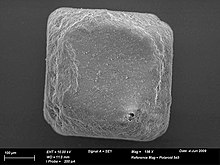
Back الآثار الصحية للأملاح Arabic 소금과 건강 Korean Kesan garam terhadap kesihatan Malay Wpływ soli na zdrowie Polish Tác động đến sức khỏe của muối Vietnamese

The health effects of salt are the conditions associated with the consumption of either too much or too little salt. Salt is a mineral composed primarily of sodium chloride (NaCl) and is used in food for both preservation and flavor. Sodium ions are needed in small quantities by most living things, as are chloride ions. Salt is involved in regulating the water content (fluid balance) of the body. The sodium ion itself is used for electrical signaling in the nervous system.[1]
Salt is usually high in ultra-processed and hyperpalatable foods.[2] In 2020, the World Health Organization (WHO) recommended that adults consume no more than 5 grams (0.18 oz) (just under a teaspoon) of salt per day, an amount providing about 2 grams (0.071 oz) of sodium per day.[3][4] The WHO further recommends that salt intake be adjusted for those aged 2 to 15 years old based on their energy requirements relative to those of adults.[3] High sodium consumption (5 g or more of salt per day) and insufficient potassium intake (less than 3.5 grams (0.12 oz) per day) have been linked to high blood pressure and increased risk of heart disease, stroke, and kidney disease.[5][6]
As an essential nutrient, sodium is involved in numerous cellular and organ functions. Several national health organizations recommend limiting sodium consumption to 2.3 g per day. However, some studies have found that sodium intake that is below 3 g per day (equivalent to about 7.5 g of salt) may increase the risk for cardiovascular disease and early death.[5][7][8]
- ^ Caldwell JH, Schaller KL, Lasher RS, Peles E, Levinson SR (May 2000). "Sodium channel Na(v)1.6 is localized at nodes of ranvier, dendrites, and synapses". Proceedings of the National Academy of Sciences of the United States of America. 97 (10): 5616–5620. Bibcode:2000PNAS...97.5616C. doi:10.1073/pnas.090034797. PMC 25877. PMID 10779552.
- ^ Monteiro, Carlos A.; Cannon, Geoffrey; Levy, Renata B; Moubarac, Jean-Claude; Louzada, Maria L. C.; Rauber, Fernanda; Khandpur, Neha; Cediel, Gustavo; Neri, Daniela; Martinez-Steele, Euridice; Baraldi, Larissa G.; Jaime, Patricia C. (2019). "Ultra-processed foods: what they are and how to identify them". Public Health Nutrition. 22 (5): 936–941. doi:10.1017/S1368980018003762. ISSN 1368-9800. PMC 10260459. PMID 30744710.
- ^ a b "Salt reduction: fact sheet". World Health Organization. 29 April 2020. Retrieved 20 November 2020.
- ^ "Sodium: How to tame your salt habit". Mayo Clinic. 29 June 2019. Retrieved 20 November 2020.
- ^ a b "Too much and too little salt is associated with increased heart risks". CardioSmart, American College of Cardiology. 24 July 2016. Retrieved 20 November 2020.
- ^ Cite error: The named reference
gc17was invoked but never defined (see the help page). - ^ Mente A, O'Donnell M, Rangarajan S, Dagenais G, Lear S, McQueen M, et al. (July 2016). "Associations of urinary sodium excretion with cardiovascular events in individuals with and without hypertension: a pooled analysis of data from four studies". Lancet. 388 (10043): 465–475. doi:10.1016/S0140-6736(16)30467-6. hdl:10379/16625. PMID 27216139. S2CID 44581906.
- ^ Cite error: The named reference
graudal_2014was invoked but never defined (see the help page).